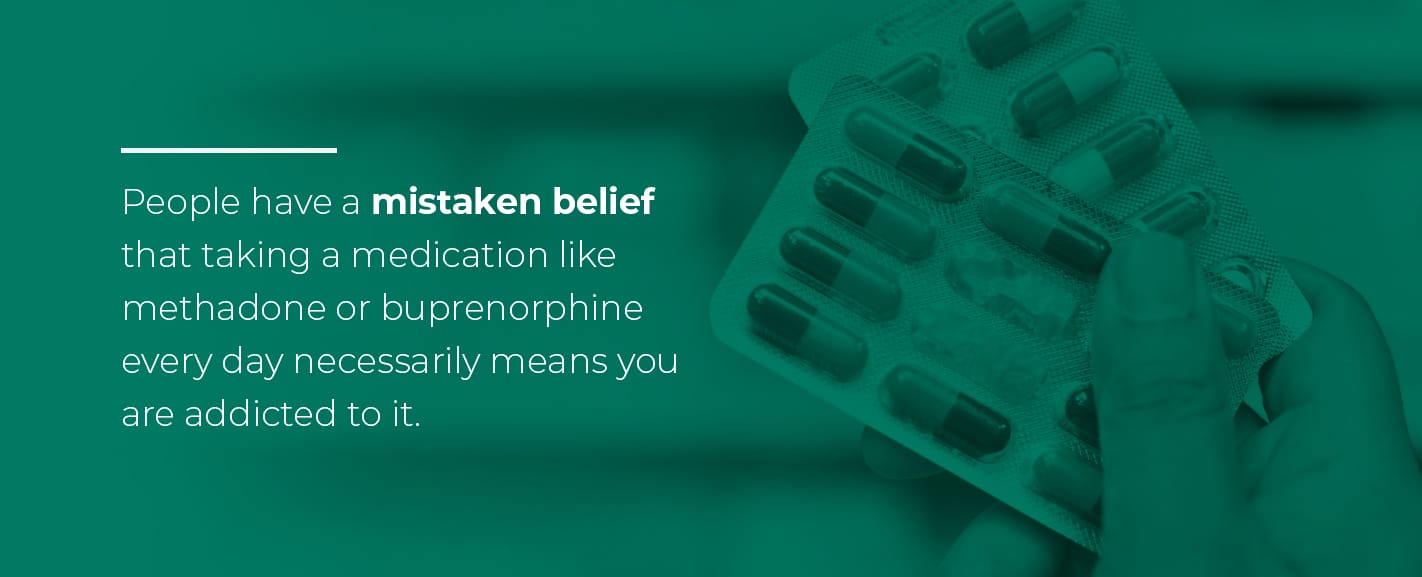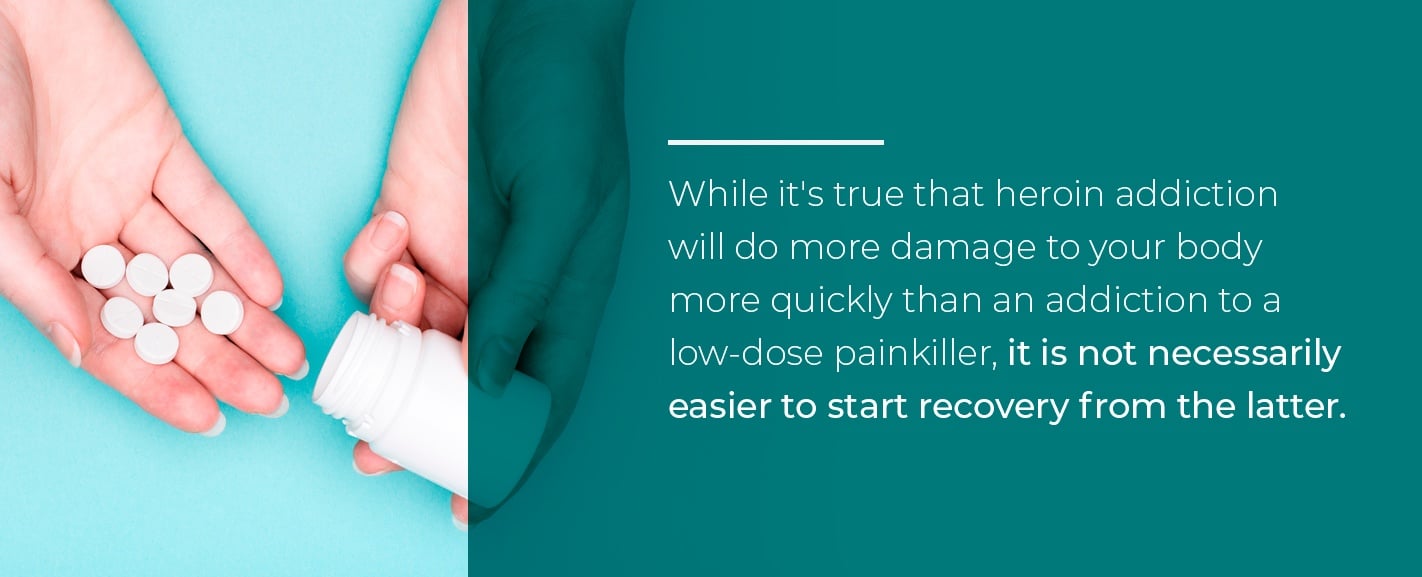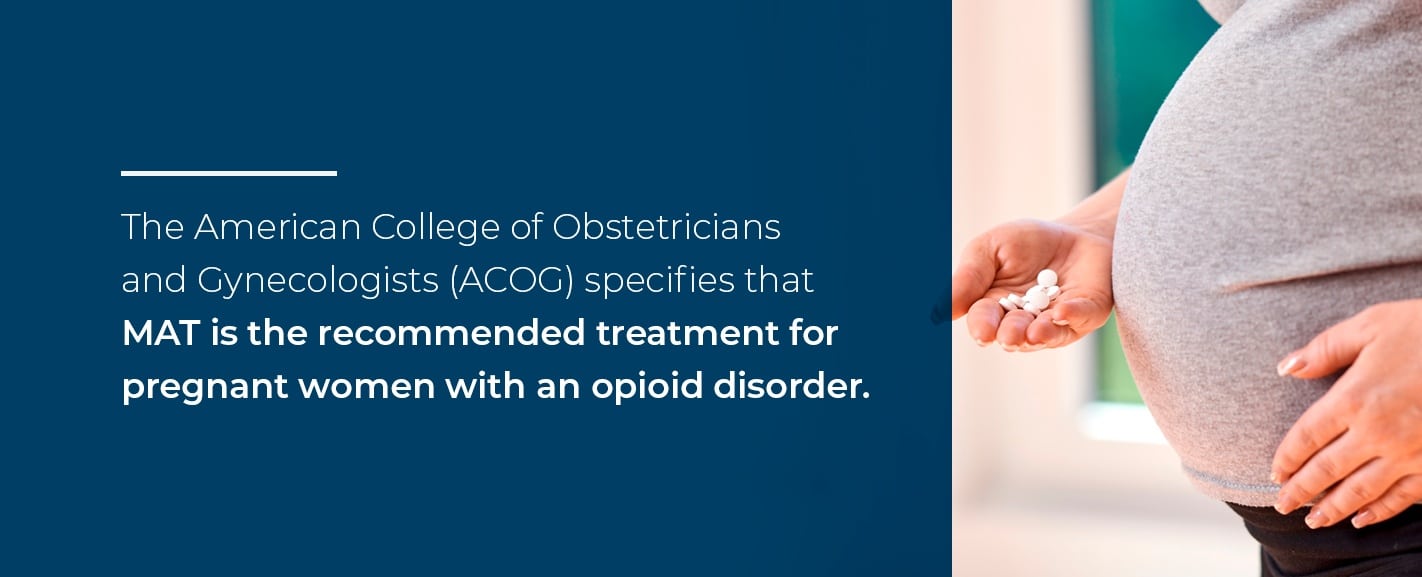Of the multiple treatment types available to address addiction to opioids, medication-assisted treatment (MAT) is considered the gold standard. Despite decades of evidence pointing to the efficacy and relative safety of MAT for individuals combating opioid addiction, many harmful myths persist among the general public about what MAT is and what it does or does not do.
If you are considering an MAT program for yourself or for a loved one, you have likely heard conflicting opinions from a variety of sources. Examining the most common myths about medication-assisted treatment may yield surprising facts that will give you a clearer vision of what it means to begin recovery with MAT.
How Does MAT Work?
Before diving into the many dangerous myths about medication-assisted treatment, it’s essential to have a strong grasp of how and why this form of treatment works. The goal of medication-assisted treatment is to wean participants off of misusing opioid drugs, both prescription and illicit, while avoiding the painful symptoms of withdrawal.
The medications most commonly used in MAT programs are methadone and buprenorphine. Methadone has been used as an addiction treatment medication since the 1970s, and buprenorphine was approved for use by the Food and Drug Administration (FDA) in 2002.
Both of these compounds work by interacting with opioid receptors in the brain. Unlike drugs of abuse like heroin or prescription painkillers, methadone and buprenorphine do not create the overwhelming feelings of euphoria that contribute to uncontrollable drug-seeking behavior because they are provided at a therapeutic dose under medical supervision. When taken as directed, these medications fulfill the brain’s craving for opioids, allowing individuals to retain day-to-day function and participate in treatment.
The Most Common Myths About MAT
There is no shortage of opinions about the efficacy of medication-assisted treatment, and unfortunately, many of them are based on unfounded myths. Being able to separate fact from fiction is essential to understanding and fully participating in treatment. The following are 10 harmful misconceptions you may hear from misinformed people.

1. MAT Is Trading One Addiction for Another.
This is the most common MAT for opioids myth. It is often used to shame people who participate in MAT. This myth originates from the delivery system in methadone maintenance treatment, in which participants must visit a methadone clinic daily to receive their medication. People have a mistaken belief that taking a medication like methadone or buprenorphine every day necessarily means you are addicted to it.
People who perpetuate this myth fail to understand the immense impact medications have on opioid use disorders. When someone can stop taking a drug they get high on without experiencing withdrawal, the uncontrollable drug-seeking urges that characterize addiction are minimized or eliminated. Participants are not getting high. They are eliminating their usage of drugs of abuse and the medication facilitates the mental and emotional stability required for participating in other aspects of recovery.
2. MAT Is Only for Short-Term Treatment.
Some people insist that MAT is ineffective because it is a short-term treatment. These individuals are usually thinking of someone they know or have heard of who has been through multiple residential rehab programs unsuccessfully. MAT does not usually fit into a 30- or 90-day box and works better when used as a long-term treatment. Methadone or buprenorphine maintenance programs allow patients to remain on their medication indefinitely.
The National Institute on Drug Abuse (NIDA) conducted a comprehensive review of available literature on methadone treatment, which overwhelmingly found that it is an effective form of treatment for opioid use disorder. One of the most compelling cases for long-term MAT is that methadone maintenance is more effective than detoxification-based treatment.
People participating in an MAT program can stay on methadone or buprenorphine as long as the medication is working for them. Before treatment begins, it’s wise to discuss with your physician how long you envision taking the medication. Some people see success with short-term treatment and a tapering off, but others need more time. Your doctor can evaluate the severity of your addiction and determine a minimum length of treatment to start with.

3. My Addiction Isn’t Severe Enough to Warrant MAT.
It’s common to believe that medication-assisted treatment is only for the “worst” of addictions. You might think that if you’re not on heroin, MAT isn’t for you. This belief often stems from the perception that some opioids are worse than others. While it’s true that heroin addiction will do more damage to your body more quickly than an addiction to a low-dose painkiller, it is not necessarily easier to recover from the latter.
All opioids, from the pain pills prescribed by a doctor to the heroin found on the black market, are highly addictive and change the brain in similar ways. MAT is suitable for anyone with an opioid use disorder as defined and diagnosed according to the criteria in the Diagnostic and Statistical Manual of Mental Disorders, Fifth Edition (DSM-5).
The DSM-5 categorizes opioid use disorder as mild, moderate or severe, but all levels of addiction require treatment. The main difference is that more severe addictions will likely require longer-term MAT to see the best outcomes.
4. MAT Increases Overdose Risk for Participants.
This is an incredibly harmful and flat-out incorrect misconception. In combination with psychosocial therapy, medication-assisted treatment is the most effective intervention for treating opioid use disorder. The reductions in illicit opioid use are significant compared to approaches that don’t use medication, and reduced opioid use, in turn, leads to a reduced risk of overdose.
A study from the National Institutes of Health (NIH) evaluated data from 2012 to 2014, on more than 17,500 adults in Massachusetts who had experienced an opioid overdose and survived. The researchers found that, in comparison to those who didn’t receive any MAT, deaths from overdose were decreased by 38% in those taking buprenorphine and 59% in those receiving methadone.
The goal of MAT is to eliminate the illicit opioid use that leads to overdoses, and this study proves both methadone and buprenorphine are effective in achieving that.
5. MAT Only Delays and Disrupts True Recovery.
You may have heard the concept that buprenorphine or methadone treatment is only a “crutch,” and prevents people from entering into “true” recovery. This attitude shows a fundamental misunderstanding of what recovery is.
In the grip of addiction, a person cannot function properly. Their main focus in life is obtaining and using drugs or alcohol, and their addiction interferes with daily life to an escalating degree. As the brain adapts to consistent and increasing drug use, the pursuit of a euphoric high turns into the avoidance of painful withdrawal symptoms. The person is no longer able to fulfill responsibilities at school or work, and their relationships begin to suffer, all because their brain demands a steady supply of a particular substance.
MAT removes the fear of withdrawal from the equation. When someone can stop using opioids without debilitating physical effects, the drug-seeking urge is greatly diminished or eliminated. This allows the individual to achieve stability and re-enter society. Recovery is defined by the ability to perform basic functions and fulfill responsibilities without drug or alcohol use is absolutely achievable with MAT.
6. MAT Is Worse Than Abstinence.
There is an ideological stance that places complete abstinence at the top of a moral hierarchy. Plenty of addiction treatment programs, especially residential ones, operate on the concept that the only way to recovery is complete abstinence from the substance of abuse and other substances or medications. This philosophy ties in with the idea that substituting methadone or buprenorphine for a stronger opioid is merely switching one addiction for another.
However, the evidence simply does not support abstinence as the most effective method of treating opioid addiction. In fact, MAT is so much more effective that the FDA is actively encouraging the development of novel MAT medications. According to U.S. Department of Health and Human Services (HHS) Secretary Alex Azar, “The evidence is clear: medication-assisted treatment works, and it is a key piece of defeating the drug crisis facing our country.”
Complete abstinence from opioids and MAT medications is an admirable goal and one that can be achieved in the long run with treatment. However, promoting abstinence as somehow better or more effective than MAT is factually incorrect.
7. Most Insurance Plans Don’t Cover MAT.
The introduction of the Affordable Care Act required the majority of insurers to cover addiction treatment, and in many cases, that includes medication-assisted treatment. Insurance may cover some or all of the cost of MAT, depending on your plan. Some plans place limits on the total amount of medication they will cover, and some require pre-authorization.
Don’t assume that MAT is not covered. Check with your insurance company to see what they will pay for. With even minimal coverage that most plans provide, you may be able to receive MAT with a reasonably low co-pay.
8. MAT Is Too Expensive.
Even without insurance, methadone or buprenorphine-based MAT is still a cost-effective treatment option for most people. According to NIDA, the following are the cost estimates for treatment:
- Methadone: $126.00 per week, including medication, integrated psychosocial therapy and medical support services.
- Buprenorphine: $115.00 per week, including medication and twice-weekly visits to the certified opioid treatment program (OTP).
In comparison to the cost of obtaining opioids of abuse, as well as the heavy price tag of treating the medical conditions that accompany chronic opioid abuse, MAT is highly affordable.

9. Pregnant Women Can’t Receive MAT.
There is a widespread misconception that taking methadone or buprenorphine during pregnancy will cause deformities or otherwise harm the baby. In reality, MAT is very safe for pregnant women. In fact, the American College of Obstetricians and Gynecologists (ACOG) specifies that MAT is the recommended treatment for pregnant women with an opioid disorder. Some babies may experience neonatal abstinence syndrome (NAS), but this is a much better outcome than can be expected with continued opioid use.
Women can continue to take methadone or buprenorphine while breastfeeding. Only insignificant amounts of these medications pass over into breast milk, and the Association of Women’s Health, Obstetric and Neonatal Nurses (AWHONN) recommends that all women receiving MAT should be encouraged to breastfeed. The benefits to the baby far outweigh the minimal risks of the infant ingesting minuscule amounts of medication.
10. Cold Turkey Is Better Than MAT.
Many people are of the opinion that people with an opioid use disorder should tough it out and “get it out of their system” by locking themselves up in a room and going “cold turkey.” This is possibly the worst approach to recovery.
Withdrawals from opioids can be excruciating, if not directly life-threatening. The combination of relentless symptoms makes people go to extreme lengths to obtain more opioids just to make the pain stop. Withdrawal is the first and highest hurdle to recovery, and it is where most people fail. In cases of very long-term and severe opioid abuse, symptoms like the dehydration from diarrhea and vomiting can require hospitalization.
Going cold turkey also has the disadvantage of doing nothing to address drug cravings. A central component of MAT is satisfying the brain’s need for opioids and quieting urges to abuse drugs, making it significantly easier to abstain from drugs of abuse.
What to Do If You’re Considering MAT
With a better understanding of opioid use disorder treatment myths, you may be realizing that you’re a good candidate for medication-assisted treatment. Getting started with MAT begins with finding a reputable treatment center near you.
You’ll need to learn more about the difference between methadone and buprenorphine to begin determining which treatment will best fit your unique needs. Your physician at the treatment center will ultimately help you decide based on a variety of factors such as relapse history and history of opioid use, but coming in with a knowledge base will make the process smoother.
You should find out what to expect at your intake appointment and be prepared to adhere to your treatment program’s policies and procedures to receive treatment. Your program will include therapy and the provision of resources to assist you as you begin your journey to recovery.
MAT is an established, effective way to stop opioid abuse and recover from addiction. Hundreds of thousands of people have seen success with MAT since it was introduced. Don’t be afraid to reach out and get the help you need.
MAT With MedMark
Choosing to do something about opioid addiction is a courageous decision, and you deserve the best treatment possible to launch your bid for recovery. MedMark Treatment Centers are federally-certified, state-licensed and have earned accreditation from the Commission on Accreditation of Rehabilitation Facilities (CARF).
We specialize in medication-assisted treatment with methadone and buprenorphine and have been providing these services since 2006. Our 34 treatment centers serve people like you in multiple states across the nation with MAT, counseling and a variety of supportive services to give you the best chance at recovery.
If you’re ready to step out of the shadow of opioid addiction, MedMark is here to help. Call us today at (866) 840-6658 to be directed to a compassionate representative at the location nearest you, or contact us online.



